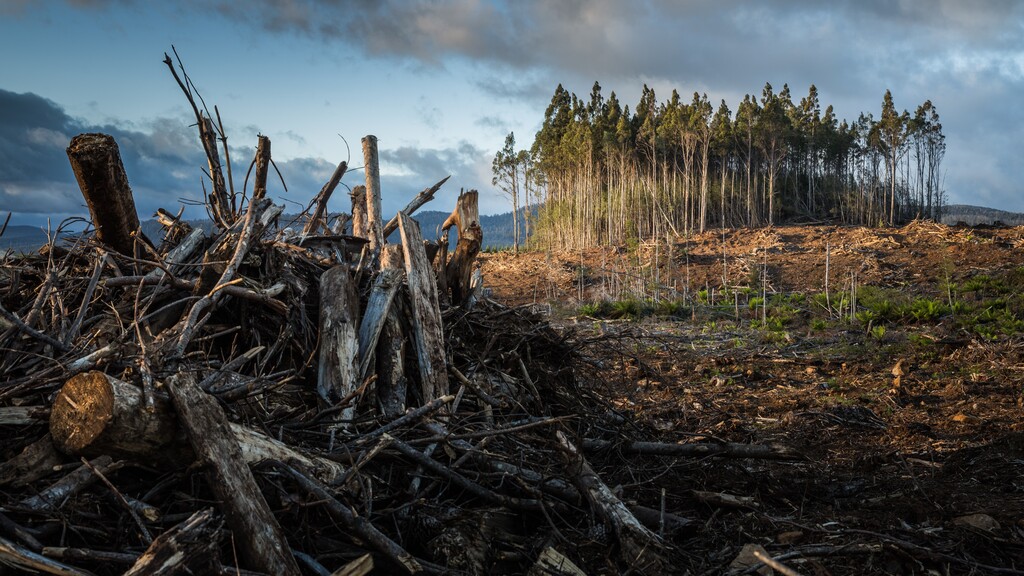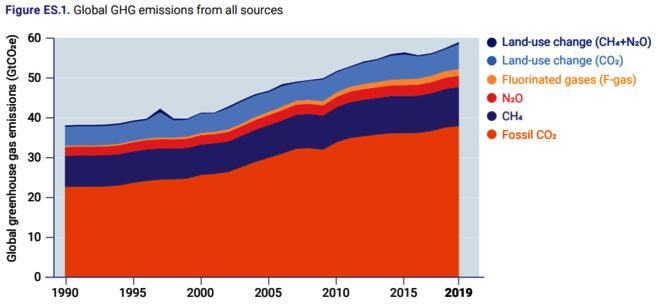

Das Klima beschreibt den Zustand der Atmosphäre an einem Ort oder Gebiet über einen mindestens 30-jährigen Zeitraum. Es wird von allen Teilsystemen des Erdsystems beeinflusst, also der Atmosphäre, den Ozeanen, dem Meer- und Landeis, den Lebensräume im Ozean und an Land, dem Wasser der Landflächen, den Böden sowie den Menschen.
Hätte die Erde keine Atmosphäre, hätte ihre Erdoberfläche eine Temperatur von durchschnittlich -18 °C. Erst die Atmosphäre schafft durch ihren natürlichen Treibhauseffekt also lebensfreundliche Bedingungen. Dafür nimmt die Atmosphäre die von der Erdoberfläche abgestrahlte Strahlung von Gasen wie Wasserdampf, Kohlendioxid (CO2), Methan (CH4) und Lachgas (NO2) in sich auf. Diese Gase strahlen wiederum Richtung Erdoberfläche zurück und erhöhen dort die Energiezufuhr und damit die Temperatur der Erdoberfläche, der Ozeane und der bodennahen Atmosphäre. Dieser natürliche Treibhauseffekt führt zu einer mittleren Erdoberflächentemperatur von +15 °C.
Seit dem Beginn der Industrialisierung nimmt die Konzentration von Treibhausgasen in der Atmosphäre durch menschliche Einflüsse beständig zu. Neben den oben genannten Treibhausgasen gelangen seitdem auch andere hoch klimawirksame Treibhausgase wie chlor- oder bromhaltige Substanzen in die Atmosphäre, welche ausschließlich vom Menschen produziert werden. Zwar machen die Treibhausgase die Erde erst bewohnbar, jedoch wird derzeit eine Zunahme der Treibhausgase in der Atmosphäre von fast 50 Prozent gegenüber dem Niveau der Vorindustrialisierung verzeichnet. Besonders steil war der Anstieg in den vergangenen drei Jahrzehnten.

Schon mit der Frühindustrialisierung um 1750 ist die weltweite bodennahe Lufttemperatur im Mittel um etwa 1 °C gestiegen und liegt gemittelt über alle Landflächen bei etwa 1,5 °C. Das Ausmaß der Erwärmung ist dabei über Land in der Regel erheblich größer als über dem Ozean und lag 2015 bis 2019 circa 1,7 °C über den Werten der vorindustriellen Jahre. Ein solches Temperaturniveau ist laut Wissenschaftlern nicht mit natürlichen Klimaschwankungen zu erklären. So belegt beispielsweise der Weltklimarat IPCC in seinen Sachstandsberichten, dass für die derzeitige globale Erwärmung in erster Linie der Mensch verantwortlich ist. Ohne die Berücksichtigung der Zunahme der Treibhausgase in der Atmosphäre kann die beobachtete Erwärmung des Klimasystems, insbesondere die Erwärmung seit den 1950er Jahren, nicht erklärt werden. Laut dem aktuellen IPCC-Bericht aus dem Jahr 2022, könnte die kritische Temperaturerhöhung von 1,5 °C bereits im Jahre 2026 erreicht werden. Die Wahrscheinlichkeit, dass diese Schwelle mindestens einmal innerhalb der nächsten fünf Jahre erreicht wird, läge laut Experten bei fast 50 %.
Nach dem Kyoto-Protokoll zählen folgende Gase zu den wichtigsten Treibhausgasen:
Laut dem Umweltbundesamt tragen die genannten Gase im unterschiedlichen Umfang zu den Emissionen bei.
Die Zunahme von Kohlendioxid in der Atmosphäre kann insbesondere durch die Verbrennung kohlenstoffhaltiger fossiler Energieträger begründet werden, also beispielsweise Kohle, Erdöl oder Erdgas. Dies geschieht vor allem in der Industrie, beim Autofahren sowie bei der Strom- und Wärmeerzeugung. Besonders verheerend für die Umwelt ist die Brandrodung oder die Zerstörung weiterer Kohlenstoffsenken wie Moore oder Graslandschaften, da bei diesen Vorgängen besonders viel vom klimaschädlichen Kohlendioxid frei wird. Große Mengen von diesem Gas gelangen als Folge in die Umwelt und Atmosphäre.
Die CO2-Konzentration in der Atmosphäre ist mittlerweile höher als jemals zuvor in den zurückliegenden 800.000 Jahren. Jüngste Forschungsergebnisse deuten darauf hin, dass vermutlich sogar in den letzten 3 Millionen Jahren die Konzentration von CO2 in der Atmosphäre nie höher war als heute. Die von Menschen freigesetzten CO2-Emissionen der Jahre 2009–2018 stammen zu 86 % aus der Verbrennung fossiler Stoffe und zu 14 % aus Landnutzungsänderungen. Etwa ein Drittel dieser Emissionen (31 %) wird von Landökosystemen aufgenommen, etwa ein Viertel (23 %) vom Ozean, während der größte Teil der CO2-Emissionen (46 %) in der Atmosphäre verleibt. Diese hohe Konzentration von CO2 in der Atmosphäre kann langfristig Teile des Klimasystems destabilisieren. Im Mittel dauert es 120 Jahre, bis das CO2 aus der Luft wieder abgebaut ist.
Wenn organisches Material unter Ausschuss von Luft abgebaut wird, entsteht Methan. Dieser Prozess läuft vor allem auf Mülldeponien, in Klärwerken und beim Nassreisanbau ab. Für den Ausstoß von Methan ist größtenteils die industrielle Landwirtschaft und dabei insbesondere die intensive Nutztierhaltung verantwortlich. Es bleibt in der Umwelt und der Atmosphäre bis zu 15 Jahren erhalten.
Auch der Anteil von Methan in der Atmosphäre hat sich im Vergleich zum vorindustriellen Niveau um circa 2,5-mal gesteigert. Da die Treibhauswirkung von Methan pro Molekül etwa 25-mal so stark ist wie die von CO2, hat auch dieser Anstieg immense Auswirkungen auf das Klima.
Distickstoffmonoxid, auch als Lachgas bekannt, wird hauptsächlich beim Düngen in der Landwirtschaft freigesetzt. Sowohl der natürliche als auch der industriell hergestellte Dünger enthalten Stickstoff. Werden diese Stickstoffverbindungen abgebaut, entsteht Lachgas. Auch auf natürliche Weise gelangt Lachgas in die Atmosphäre: Wasserinsekten, Muscheln und Schnecken geben diese Gase frei, das Treibhausgas entsteht bei ihnen im Darm während der Verdauung.
Lachgas als Treibhausgas bleibt rund 114 Jahre in der Atmosphäre erhalten. Es wirkt sich 298-mal so stark auf das Klima aus wie Kohlendioxid.
Die Fluorchlorkohlenwasserstoffe werden hauptsächlich als Treibsubstanz in Spraydosen verwendet. Auch als Kühlmittel wird das Gas eingesetzt. Schon im Jahr 1987 wurde im Montrealer Abkommen ein schrittweiser Verzicht auf FCKW vereinbart, da sie die Ozonschicht schädigen. In der EU ist es schon seit 1995 verboten. Als Ersatz dient heutzutage Fluorkohlenwasserstoff, welcher zwar keine Auswirkungen auf die Ozonschicht hat, sich dennoch als Treibhausgas massiv auf das Klima auswirkt.
Die sogenannten F-Gase sind die stärksten unter den Treibhausgasen. Sie können sich 100- bis 24.000-mal stärker auf das Klima auswirken als Kohlendioxid. Sind diese Gase erst mal in der Atmosphäre, dauert es bis zu hundert Jahre, bis sie abgebaut sind.
Die gute Nachricht ist: Bei all den genannten Treibhausgasen haben wir die Möglichkeit entgegenzusteuern, etwa durch die Förderung einer nachhaltigeren Landwirtschaft, dem Schutz von Wäldern oder der Bewahrung von Mooren. Wenn auch Sie aktiv zum Schutz des Klimas beitragen wollen, erkunden Sie gerne die Naturschutzprojekte von Naturefund, bei denen langfristig Land für Natur gesichert und so die Freisetzung weiterer Treibhausgase verhindert wird!
Quellen:
Leopoldina; Bundeszentrale für politische Bildung; Klimafakten; UN environment programme; Umweltbundesamt; Tagesschau